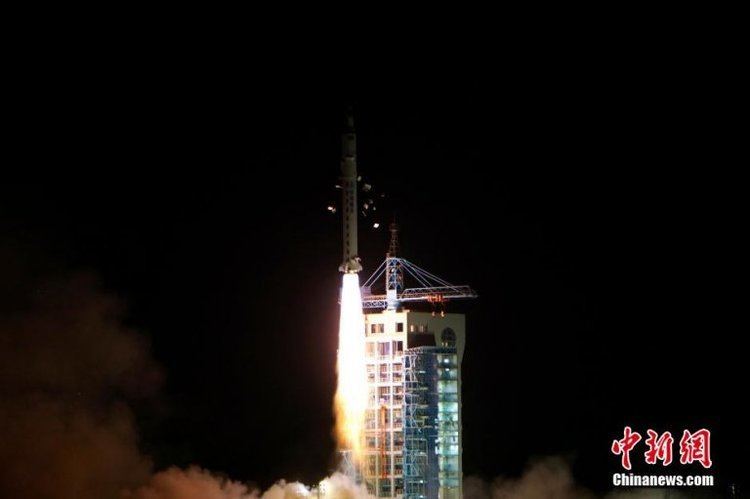COSPAR ID 2016-051A | Mission duration 2 years (planned) | |
 | ||
Mission type Technology demonstrator Manufacturer Chinese Academy of Science | ||
Quantum Experiments at Space Scale (QUESS; Chinese: 量子科学实验卫星; pinyin: Liàngzǐ kēxué shíyàn wèixīng; literally: "Quantum Science Experiment Satellite"), is an international research project in the field of quantum physics. A satellite, nicknamed Micius or Mozi (Chinese: 墨子) after the ancient Chinese philosopher and scientist, is operated by the Chinese Academy of Sciences, as well as ground stations in China. The University of Vienna and the Austrian Academy of Sciences are running the satellite’s European receiving stations. QUESS is a proof-of-concept mission designed to facilitate quantum optics experiments over long distances to allow the development of quantum encryption and quantum teleportation technology. Quantum encryption uses the principle of entanglement to facilitate communication that is totally safe against eavesdropping, let alone decryption, by a third party. By producing pairs of entangled photons, QUESS will allow ground stations separated by many thousands of kilometres to establish secure quantum channels. QUESS itself has limited communication capabilities: it needs line-of-sight, and can only operate when not in sunlight. If QUESS is successful, further Micius satellites will follow, allowing a European–Asian quantum-encrypted network by 2020, and a global network by 2030.
Contents
The mission will cost around US$100 million in total.
Mission
The initial experiment will attempt to demonstrate quantum key distribution (QKD) between Xinjiang Astronomical Observatory near Ürümqi and Xinglong Observatory near Beijing – a great-circle distance of approximately 2,500 kilometres (1,600 mi). In addition, QUESS will test Bell's inequality at a distance of 1,200 km (750 mi) – further than any experiment to date – and teleport a photon state between Shiquanhe Observatory in Ali, Tibet Autonomous Region, and the satellite. This requires very accurate orbital maneuvering and satellite tracking so the base stations can keep line-of-sight with the craft.
Once experiments within China have concluded, QUESS will then attempt to create an international QKD channel between China and the Institute for Quantum Optics and Quantum Information, Vienna, Austria − a ground distance of 7,500 km (4,700 mi) – and possibly other European stations.
Launch
The launch was initially scheduled for July, but was rescheduled to August, with notification of the launch being sent just a few days in advance. The spacecraft was launched by a Long March 2D rocket from Jiuquan Launch Pad 603, Launch Area 4 on 17 August 2016, at 17:40 UTC (01:40 local time).
Multi-payload mission
The launch was a multi-payload mission shared with QUESS, LiXing-1 research satellite, and ³Cat-2 Spanish science satellite.
Secure key distribution
The main instrument on board QUESS is a "Sagnac effect" interferometer. This is a device which generates pairs of entangled photons which can then be transmitted to the ground. This will allow QUESS to perform Quantum key distribution (QKD) – the transmission of a secure cryptographic key that can be used to encrypt and decrypt messages – to two ground stations. QKD theoretically offers truly secure communication. In QKD, two parties who want to communicate share a random secret key transmitted using pairs of entangled photons sent with random polarization, with each party receiving one half of the pair. This secret key can then be used as a one-time pad, allowing the two parties to communicate securely through normal channels. Any attempt to eavesdrop on the key will disturb the entangled state in a detectable way. QKD has been attempted on Earth, both with direct line-of-sight between two observatories, and using fibre optic cables to transmit the photons. However, fibre optics and the atmosphere both cause scattering which destroys the entangled state, and this limits the distance over which QKD can be carried out. Sending the keys from an orbiting satellite results in less scattering, which allows QKD to be performed over much greater distances.
In addition, QUESS tests some of the basic foundations of quantum mechanics. Bell's theorem says that no local hidden variable theory can ever reproduce the predictions of quantum physics, and QUESS will be able to test the principle of locality over 1,200 km (750 mi).
Analysis
QUESS lead scientist Pan Jianwei told Reuters that the project has "enormous prospects" in the defence sphere. The satellite will provide secure communications between Beijing and Ürümqi, capital of Xinjiang, the remote western region of China. The US Department of Defense believes China is aiming to achieve the capability to counter the use of enemy space technology. Paramount leader Xi Jinping has prioritised China's space program, which has included anti-satellite missile tests, and the New York Times noted that quantum technology was a focus of the thirteenth five-year plan, which the China government set out earlier that year. The Wall Street Journal said that the launch put China ahead of rivals, and brought them closer to "hack-proof communications". Several outlets identified Edward Snowden's leak of US surveillance documents as an impetus for the development of QUESS, with Popular Science calling it "a satellite for the post-Snowden age".
Similar projects
QUESS is the first spacecraft launched capable of generating entangled photons in space, although transmission of single photons via satellites has previously been demonstrated by reflecting photons generated at ground-based stations off orbiting satellites. While not generating fully entangled photons, correlated pairs of photons have been produced in space using a cubesat by the National University of Singapore and the University of Strathclyde. A German consortium has performed quantum measurements of optical signals from the geostationary Alphasat Laser Communication Terminal.
